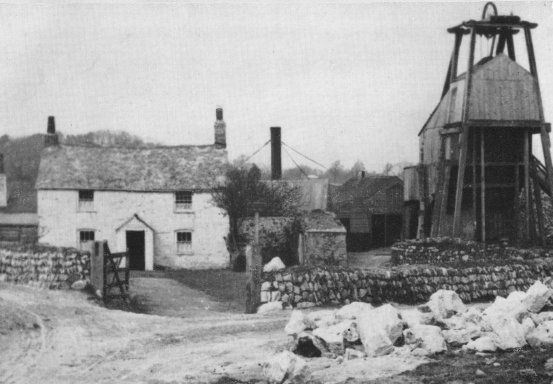|
|
|||||||||
|
|
 |
||||||
|
Wheal Gorland, Wheal Unity and Wheal Muttrell Information on the old mines in Cornwall where Liroconite was found is extremely hard to find. These were operating over 200 years ago and few records were then made. Those that were have often not survived. A.K.Hamilton Jenkin conducted a large amount of research into the old mines of Cornwall, and wrote this fascinating account of Wheal Gorland, Wheal Unity and Wheal Muttrell in his book "Mines and Miners of Cornwall – Around Gwennap" in 1963. |
||||||
 |
||||||
|
WHEAL GORLAND, GWENNAP, CORNWALL circa 1905 |
||||||
|
Wheal Unity Despite the reduction in pumping charges which resulted from their being linked to the County Adit, not all the mines thus served proved equally successful. Among the richest was Wheal Unity from which, in the years 1792-98, the adventurers' part of the ore (after dues had been deducted) amounted in value to £197,573 and realised a profit of £101,604. By 1819, Wheal Unity had been sunk to 144 fathoms below the deep adit, and was equipped with three steam engines of 60, 58 and 52 in. cylinders. Strange as it may seem, the water for the dressing purposes was derived from the adit of Pednandrea Mine in Redruth, being carried thence in a leat six miles in length. Near Scorrier Station the leat passed through a tunnel 700 fathoms long, finally delivering the water to the "floors" which lay near Wheal Unity Wood.
Wheal Gorland Westward of Wheal Unity, the same lodes were developed in Wheal Gorland. The latter, although a treasure-house of rare and beautiful minerals, was a "bunchy" mine – sometimes poor, at other times so rich that close watch had to be kept on the men to prevent them selling the most valuable ore as specimens to mineral dealers. In 1792 a 1/32 part in the concern had been purchased by Robert Were Fox, "on speculation". Three years later, however, the prospects were so flattering that it was decided to erect an engine, and to sink the shaft to 60 fathoms before cutting into the lode. "This" wrote William Jenkin, "is mining on a large scale indeed. Where the lode has been wrought at about 40 fathoms deep it has produced several parcels of ore – but 'tis judged best to leave that spot for the present and sink 20 fathoms deeper where the Adventurers expect to find the lode richer and more regular than at the former level". At 100 fathoms depth, however, the Gorland lode was "still a great gozzan and not yet into ore. I confess" wrote William Jenkin to the Marquis of Buckingham's steward, "that this lode has cured me of the of the itch of boasting and I hope the Marquis will be pleased to excuse me for writing so strongly as I have in its favour. I wrote as I believed and judged – and had no other motive but to express the satisfaction I felt from the expectation of seeing a good return, and am still willing to risk the credit of my judgement as a Miner that it will yet answer the character I have given it." During the years 1792-98, although ores were sold to the value of £20,119, there was a net loss on working of £4,579. In the period 1800-04 further sales of 5,907 tons realised £52,012 which left the adventurers with a small profit. Notwithstanding this, William Jenkin was fain to describe Wheal Gorland in 1802 as "not", on the whole, "a gainful concern", despite the fact that the same lode in Wheal Unity had by this time given the adventurers in that mine a clear profit of £200,000. During the year 1813 a quantity of malleable (native) copper was returned from Wheal Gorland which was so pure that it was despatched to the smelters packed in fish casks. By 1819 the mine had been developed to 96 fathoms below the County Adit, and was still being worked in depth. There was no engine on the property at the time, the water finding its way through to Wheal Unity which lay so nearly adjoining. From 1800 to 1840 the aggregate profit amounted to £60,000; whilst in the years 1815 – 51 40,751 tons of ore were sold for £255,470. As these figures show, William Jenkin's faith in the mine was, ultimately, justified.
Wheal Muttrell During the 1790's the northern part of Wheal Gorland had been worked under a separate grant known as Wheal Muttrell. Through being connected to the County Adit, here about 50 fathoms below surface, no engine was required and £1,249 worth of copper ore was sold by the little mine between 1795 – 8. The lode, however, was chiefly productive of tin, and when subsequently merged with Wheal Gorland was developed to an inclined depth of 126 fathoms.
|
 |
|||
|
Copyright (C) 2003-2008 David Aubrey-Jones. All rights reserved. No part of this Web site and its contents may be reproduced in any form without the written permission of the author. |
|||
|
[Liroconite] [Rarity] [Discovery] [Habit & Form] [Descriptions] [Locations] [Cornish Minerals] [Links] [About us] |